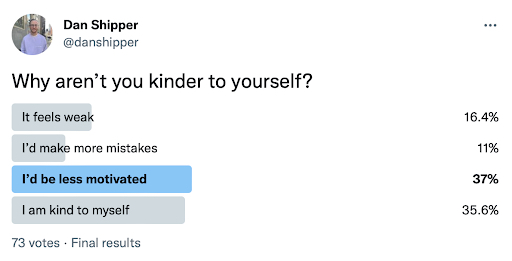
Perfectionism: Why and How to Beat It
A Guide to Doing Great Work without Fixating on Flawlessness
May 28, 2022
Sponsored By: Flatfile
There comes a time in every project that you’re tasked with implementing a CSV importer. With Flatfile, you no longer have to agonize over starting from scratch...again.
Slash time-to-value, onboard customers faster, and cut product churn with a 1-click data import experience from Flatfile:
- Cut hours off data cleaning and focus on growing your company.
- Import customer data in less than 60 seconds.
- Migrate data using stringent compliance standards
Since launching in 2018, Flatfile has onboarded data for over 1.5 million customers spanning 400+ of the best companies around the world. In just a few clicks, Flatfile intelligently imports, transforms, and validates your customers’ data, solving the most critical part of onboarding, in seconds.
I’m not a perfectionist, I’m too enlightened for that. But I am concerned with making things turn out great. Both performance-wise, and morally. I know you can’t achieve perfection, but you can asymptotically approach it. And that’s really all I’m after.
When the graph of my performance approaches the asymptote it’s like no other kind of high. When I’m pounding out words and they’re coming out right, or I’m making decisions and moving the pieces around on the chess board at Every and watching the numbers go up, or someone tells me I’m a good person or I did a good job. Ahhh, the best.
When that’s happening it’s like there’s an invisible string pulling me up by my heels, straightening my back, and puffing out my chest, so I’m gliding on tiptoes down the street. I’m proud, I’m special, I’m happy, I’m motivated. In short: I’m the shit.
My co-founder Nathan, though. He’s a perfectionist. You should see that man design a logo, or write a sentence. Agonizing over every little detail. Crushed when it doesn’t go right. I’ve been trying to help him with it. (May I remind you that I’m a Very Good Person—not yet Jesus, but approaching the asymptote!)
The thing is I haven’t been able to fix Nathan yet. Perfectionism is a tough nut to crack.
That’s why I got so excited when Dr. Clarissa Ong and Dr. Michael Twohig, the authors of The Anxious Perfectionist, reached out to me about their book. It’s about science-based tools for overcoming perfectionism, and so I suddenly had a perfect plan: Nathan could read the book, and then I could have him chat with the perfectionism people, and maybe he’d figure out how to chill out. I set up a call with all of us, but Nathan didn’t show up. (Classic perfectionistic avoidance.)
But I was on the call, so I started talking to them about perfectionism—you know, for the science of it all. And a lot of what they said sounded um familiar. I took one of the classic tests, the Frost Brief Perfectionism Scale, and scored a 32 out of a possible 40. And something began to dawn on me:
When it’s something I’m doing, perfectionism is just what’s called “doing a great job.” When someone else is doing it, it’s called perfectionism.
What I learned from Michael and Clarissa is that most people don’t really understand what perfectionism is. We think it’s about doing great work, and we wear it as a badge of honor to show how much we care. We don’t really want to give up on perfectionism, because we think that means giving up on the exact traits—like high motivation, and attention to detail—that make us awesome and make our work awesome.
I know how I got this way. I realized early on that if I jacked up the perceived costs of my mistakes I was much more likely to have the energy and drive to do more and better work. And I don’t think I’m alone:
But what I learned from Clarissa and Michael is that perfectionism doesn’t actually lead to better performance or work outcomes. Instead living with perfectionism creates avoidance behaviors like burnout and procrastination, induces extreme amounts of micromanagement, and often causes sufferers to miss the forest for the trees. It can sometimes even lead you to try to fix all of the flaws in your co-founder rather than looking deeply at yourself. (I am, of course, not speaking from personal experience here at all.)
What’s most interesting, though, is that working on perfectionism doesn’t mean giving up on doing great work. It’s not the wanting to do great work that’s the problem in perfectionism—it’s that people who suffer from it are extremely rigid about what good work looks like, and how it should be accomplished. The rigidity is the problem, not the desire to do great work.
If you can work on the rigidity, you can actually do more and better work—without suffering from the negative consequences of perfectionism.
This was a pretty big realization for me and so I wanted to go down the rabbit hole with it.
I wanted to understand: how do we do great work without falling into the trap of perfectionism? I asked Clarissa and Michael to co-write this article with me to help us answer that question. They’ll define what perfectionism is, and outline strategies that we can all use to work with our perfectionistic tendencies.
Let’s dive in!
What is perfectionism?
Perfectionism is the intersection between excessively—usually unrealistically—high standards and rigid adherence to those standards.
Usually, in perfectionism the standards are not the problem. The problem is the rigidity around those standards. The rigidity means it’s all or nothing, so we hyperfocus on achieving our impossible goals, only to burn out, neglect other responsibilities, avoid our goals altogether, or constantly feel miserable even when we’re objectively doing well.
Using this formula, rules + rigidity = perfectionism, we can usually distill perfectionism down to a set of rules we have in our heads, such as “I can’t compromise if I want to be successful,” “I need to do things the right way,” or, “If I don’t succeed, there’s no point.”
Often these rules are helpful. They can be motivating, and they point you in the direction of what you most value: doing great work. But the problem is following these rules rigidly all the time can have the opposite effect of their intended purpose: they end up moving you further away from the outcomes you’re striving so hard to attain.
The antidote to perfectionism is not getting rid of your rules—it’s understanding what they’re designed to help you achieve, noticing situations where they’re helpful versus hurting, and being flexible enough to follow them when they’re helpful and disregard them when they’re not.
The science supports it: we’ve conducted several studies that have found that the skills covered in this article enhance well-being and reduce the psychological symptoms present in perfectionism.
From rules to real life
Take a second to think about some of the rules you’re following around your work. What are a few that come to mind?
Here’s one that might resonate: “If I don’t completely pour myself into my work, it won’t be any good.” Or here’s another one: “If small details are off, it ruins the whole thing.” Or here’s another one: “No one else cares about the work as much as I do, so I have to work twice as hard to make sure things turn out okay.”
Following a rule is like a cognitive shortcut: in every situation where you want to do good work, you can just follow the rule—you don’t have to think about it too much. In the behavioral psychology community there are two kinds of rule following: tracking and pliance. Tracking means you’ve found a rule, and it’s been reinforced by positive outcomes when you’ve followed it in the past. Pliance means you’re following a rule because you think you’re expected to by other people.
The problem is, once we’ve found a rule that’s been reinforced, either by good outcomes or by social pressure, we hold to it so tightly that we often become blind to places where it doesn’t work. Psychologists call this rule-governed behavior. When we’re under the sway of rule-governed behavior it’s like we’re trying to navigate with an old map. We’re so focused on trying to follow the map exactly that we don’t notice that the roads have changed. (If you want to see a good study on how this works, click here.)
When our rules don’t work, we often blame external circumstances, or blame ourselves. Rather than disconfirming the rule, it seems to reconfirm for us that we need to follow it more: “I’m burned out and can hardly think straight but I know this project didn’t succeed because I didn’t put enough of myself into it.”
This is where we get into trouble. It’s how our perfectionistic tendencies can make us believe that we’re only trying to do great work—but actually lead to avoidance, burnout, damaged relationships with teammates, procrastination, and general misery.
So, what to do? Well, what we want is to look at when the rule is actually working and when it isn’t. This is what we call contingency-shaped behavior. That’s a fancy word for learning to be aware of when your behavior is moving you closer to the thing you want, and learning how to change your behavior when it’s not working—rather than blindly following a rule over and over again regardless of outcome.
Letting your experience teach you is a much more effective way to run your life than the rigid rule-following common to perfectionism. And if you want to start doing that, what you first need to do is understand what you want.
Our favorite way to do that is by exploring your values.
Following your values
Values are directions you want your life to go in, and qualities of the journey you want to go on. These directions and ways of being can become guideposts for you when you’re faced with challenging circumstances and you’re caught in the grip of perfectionism.
For example, one of your values might be work wholeheartedly. Another might be play loose, and take risks.
Values are a little tricky to get the hang of, because they seem like goals but they’re actually different in important ways. Goals are milestones with specific endpoints like, “Get to ramen profitable” or “Double our subscription business this year.”
Goals are necessary and important—especially when you’re starting a company or trying to level up your career. But, especially in the psychological arena, the problem with goals is that they have an end date. Once you accomplish them you often end up feeling lost and rudderless.
By using values, and thinking about them as directions they become an inexhaustible form of motivation and reward: you can’t ever go all the way in a direction, you just keep going.
You can’t ever finish “working wholeheartedly”—you’re either doing it or you’re not. Same thing for “playing loose and taking risks”—in any given moment you could be doing that, regardless of the size or scale of your company, or what’s going on in your job.
Finding your values helps to find the things that are most intrinsically motivating to you, and framing them as values helps to keep them available to you at all times. This is important when working with perfectionism because when you’re encountering a situation that triggers avoidance, or procrastination, or hyper attention to detail you always want to be able to find a frame of reference that can orient you back to what you want. Your values provide you with a place to turn to. The science backs it up too: study participants are much more likely to approach a difficult or painful circumstance if doing so relates directly to a personal value.
The question is: how do you find your values?
Your rules point to your values
The real mind-fuck of it all is that the best way to find your values is to start with the rules themselves. Yes, that’s correct: all of the perfectionistic thoughts and ideas that are driving you mad can actually be a gift. They point the way to what’s most important to you.
For example, if you have a rule like, “If I don’t completely pour myself into my work, it won’t be any good”, it probably means that you care deeply about creating high quality work. It also means that because of your life experiences you’ve learned that following this rule is the way to accomplish the thing you care about.
We recommend taking some time to explore your rules in this way. But be careful to separate out rules that you’re following because you think you “should”—i.e. because they help you conform to socially expected standards of behavior—rather than rules you’re following because you intrinsically want the results of following them.
Think about where they came from, the times when they were reinforced for you, and whether you’d follow them if no one was watching.
Take out a sheet of paper and write some of your values down. It’s crucial in this process to make sure that your values are 100% within your control. This is important, because we want them to be available to you at any moment—regardless of what’s going on in your life. Some examples might be things like:
- Do work I’m proud of
- Challenge myself
- Do things that are intended to help others
- Do meaningful work
- Intend to make a big impact
Once you’ve done that, it’s time to answer an important question: how consistent are your actions with these values? Especially around work.
Are you living up to your values? Or are you burning up in a mess of anxiety, procrastination, self-flagellation, doubt, and burnout?
If you’re experiencing the latter, keep reading. We’re going to show you how to use the values you’ve just defined to face up to the rigid-rule following that is keeping you trapped.
Ready to work with perfectionism in the moment? Let’s go.
Working with perfectionism in the moment
When you’re squarely in the jaws of perfectionism, it can be hard to think of anything but mistakes: yours or those of others.
Your consciousness collapses onto the slightly wonky slide in your pitch deck, or the missed growth numbers for the month, or the email your team member misworded to an important customer. Suddenly, you’re worried or ruminating. You’re angry or annoyed. You feel compelled to run away, or to take action right now to stop the noise in your head.
But now you’re caught in a pincer. You can either avoid a problem you know is there and end up procrastinating or feeling burned out. Or you can take the problem on and risk making it worse by exhausting yourself, or pissing off members of your team.
When you’re caught in this pincer you’ll know it’s a good opportunity to work on your relationship to perfectionism. That sense of urgency you have, that drive for what psychologists call a “felt sense of completion”—it’s very similar to the thoughts and feelings that addicts experience when they crave their drug of choice.
Here’s how to work with it.
Awareness
The first thing you need to do in this kind of situation is to be aware of it. For those of us who identify as perfectionists, this will be tricky because it might be like recognizing being hungry or thirsty: it happens so often that it easily blends into the background.
But awareness is powerful because once you can do it consistently it gives you the freedom to develop a new skill: the ability to get some space from the thoughts and feelings you’re experiencing. This is what psychologists call defusion.
Defusion
Defusion is the ability to look at a thought as a thought without necessarily buying into its content, or allowing it to automatically change your behavior.
There are a variety of ways to do this: mindfulness, journaling, or creating a CBT-style thought diary. (For more ideas, see our book.) This process will seem scary at first. Not buying into perfectionistic thoughts will feel like it will lead to failure, or ridicule. But, oddly enough, the thought that you might fail is itself a thought—and one that can be defused from in the same way.
The point here is not to convince ourselves that mistakes aren’t a big deal, or that work is “good enough as is,” or that there isn’t any validity to what you’re experiencing. The point is that putting some space between you and your thoughts will help you move from a place where you have to react to them, to a place where you have the freedom to choose how, when, and if you want to respond.
Once you’ve defused from your thoughts sufficiently, and you have the freedom to choose how to behave, the next step is to remember what you want: to return to your values.
Respond from your values
When you’ve sufficiently unhooked from your thoughts and feelings, it can feel a little scary. You’re not doing your default behavior automatically anymore, so now the question becomes: how should I behave?
This is where values come in. By referring back to your values you can make a choice in the moment to act in accordance with them. They’ll help you steer the ship more clearly even when you’re feeling stressed and lost, kind of like a lighthouse to guide you in a storm.
Crucially, choosing to respond in this way will likely feel quite different than following your rules. You’ll be more open to seeing what works and what doesn’t. You may find things that surprise you: like if you wait a bit to respond, sometimes the issue you’re thinking about just resolves itself. Following your values creates variability in behavior. And variability in behavior is good. It allows you to learn new things.
Putting all this into action
Collectively, we have been psychologists (or seeing one, or both) for a long time. In the vast majority of situations, small, slow, steady change is best. The all-or-nothing perfectionist inside you probably doesn’t like that plan. It’s probably screaming, “Tell me exactly what to do and I will make it happen.” We suggest letting that part of you scream and try to find one little change that is in line with your values instead of your drive to quell some inner drive.
Think of one step you can take in the direction of following your values a bit more closely while feeding your perfectionism less. This might be only proofreading emails once so that you have a bit more time in your day. Maybe you could take the email “ding” off your phone so you don’t respond so quickly and have a little more time with those around you. Maybe you could let your teammate make a decision so that you have less on your plate.
Choose something embarrassingly easy. We prefer you find something that you can actually do, rather than making a gigantic commitment that will be hard to follow through on. While making this change, practice the skills we talked about, connect with your values, see your rules, and step back and see if you really need to listen to them.
After you make this change, pause for a bit and see how it worked for you. For example, if you let someone else make a decision, wait a week and see how it turns out. Maybe your rule that you need to double check things has exceptions. Or maybe the slight difference in choice actually wasn’t a big deal. It is even possible that you like the way this person did it—or maybe you don’t. Don't judge impulsively. Let this small tweak settle in and see if it has any benefits.
If you do glean some benefits, keep going. For most people, learning how to make choices based on values, and selectively listen to their perfectionistic urges, is positive. But don’t just judge it on how it feels. See how well this way of being in the world works for you. You just might find that life is a little better, those around you enjoy you more, and you’re even doing better work.
After all, that’s the whole point.
If you liked this article you should check out Clarissa and Michael’s book, The Anxious Perfectionist for more details on how to deal with perfectionism in your life.
If you want to go deeper on exploring the intersection between psychology and productivity, Every has you covered. A few articles you might enjoy reading next:
- How To Do Hard Things, by Casey Rosengren
- Will Worrying Make You Better, by Dan Shipper
- Why You're Not Doing Creative Work, by Dan Shipper
Thanks for reading! And if you want us to cover any particular topic or problem areas in your life feel free to leave a comment or let us know in the feedback form. We read everything you send us :)
Find Out What
Comes Next in Tech.
Start your free trial.
New ideas to help you build the future—in your inbox, every day. Trusted by over 75,000 readers.
SubscribeAlready have an account? Sign in
What's included?
-
Unlimited access to our daily essays by Dan Shipper, Evan Armstrong, and a roster of the best tech writers on the internet
-
Full access to an archive of hundreds of in-depth articles
-
-
Priority access and subscriber-only discounts to courses, events, and more
-
Ad-free experience
-
Access to our Discord community
Thanks to our Sponsor: Flatfile
Thanks again to our sponsor Flatfile for today's newsletter. Click below to view the data onboarding platform that the world’s best companies use to onboard their customers.






Comments
Don't have an account? Sign up!